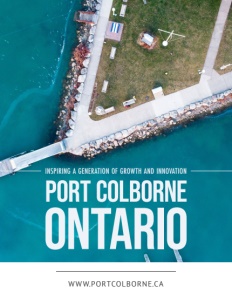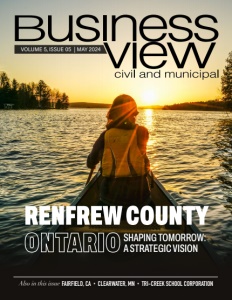City of Port Colborne, Ontario
Inspiring a Generation of Growth and Innovation
Transforming prime industrial landscape and maritime heritage into a thriving hub for business and community development.
Port Colborne, Ontario, a city with deep maritime roots and a burgeoning residential landscape, encapsulates a compelling mix of history, industry, and community growth. Situated at the confluence of the Welland Canal and Lake Erie, the city initially thrived as an industrial marine hub. Today, it is witnessing a dynamic evolution, balancing its rich industrial past with residential and commercial expansion.
Mayor Bill Steele outlines the transformation of Port Colborne from its industrial beginnings to a vibrant residential community. “Port Colborne primarily was an industrial marine town. Our population has now reached 20,500, making us the second fastest growing community in Niagara on a percentage basis,” he explains. The city’s growth is evident in the surge of building permits—from a modest 20 to nearly 200 a year, signaling a shift towards more residential and commercial development.
The city’s strategic location is further bolstered by its connectivity. “We have two major highways, Highway 140, which connects to Highway 406 taking you to Toronto, and Highway 3 west to Windsor, and east to Buffalo, just 30 minutes away,” the mayor describes. This network facilitates efficient transport and commerce and enhances the accessibility and appeal of Port Colborne as a place to live and work.
Parks and Community Engagement
As Port Colborne continues to grow and attract new residents and tourists, city officials are keenly focused on enhancing the quality of life through significant upgrades to public spaces and community facilities. The thrust of these efforts is evident in the comprehensive redevelopment of the city’s parks and recreational areas, which Mayor Steele discusses with enthusiasm.
“We have more parks per capita than most major cities in Ontario. We’ve just completed a comprehensive parks master plan, aiming to create larger, more engaging community spaces rather than small, underused plots.” The strategic overhaul is about expanding green spaces and transforming them into vibrant hubs for community interaction and recreation.
“Through this plan, we’re consolidating smaller parks and enhancing larger ones like Lockview Park,” Mayor Steele continues.” The three-acre park is undergoing a transformation to include housing and a neighbourhood park with walking tracks, outdoor sports facilities, and ample communal spaces.”
The redevelopment extends beyond just physical spaces. Mayor Steele outlines how these parks are strategically connected: “We’re integrating our parks with major trails that link across the city, enhancing accessibility and enjoyment for our residents. For instance, trails from Lockview Park will connect to our main north-south canal trail, eventually leading to our largest recreational complex, the Vale Centre.”
Infrastructure and Innovation
Port Colborne is actively addressing its infrastructure needs, focusing on critical developments to shape the city’s growth and functionality in the coming years. Steve Shypowskyj Director of Public Works, outlines a significant project to illustrate the city’s proactive approach:
“We’re currently planning a crucial infrastructure development involving the installation of a service tunnel beneath the canal. The tunnel will connect the regional water tower on the west to the east side of town, significantly enhancing our service capacity and reliability.” The development is a structural improvement and a strategic expansion of the city’s capabilities, providing necessary services to previously inaccessible areas.
“The new tunnel will facilitate the development of the East Side Employment Lands, creating opportunities for industrial properties and providing an additional sewage line back to our treatment plant,” Shypowskyj adds. The forward-thinking project is expected to improve service efficiency across the city and catalyze economic growth by making the east side more attractive for business and residential developments.
Broadband and Housing Developments
In the evolving urban fabric of Port Colborne, the intersection of technology and infrastructure is creating new possibilities for growth and connectivity. Mayor Steele elaborates on how Port Colborne is broadening its infrastructure to include more than just traditional utilities.
“When we planned the canal tunnel project, I insisted we think bigger—beyond water and sewer. We brought in electrical and telecommunications providers to integrate broadband and other services through the tunnel, boosting our capabilities in the city’s largest growing area,” he explains.
In addition to its technological strides, Port Colborne is addressing a critical issue facing many communities: housing diversity and affordability. Scott Luey, the Chief Administrative Officer, discusses the city’s strategic approach to housing. “We’ve recognized a lack of diversity in our housing stock. City council’s newly implemented strategic plan addresses this by promoting various housing options for different life stages,” he states. The plan includes incentives for developers to build homes which cater to a broader demographic, from young families to empty nesters looking to downsize.
Mayor Steele adds context to the housing initiatives, focusing on community support and inclusivity. “We’ve partnered with Port Cares on a project that offers 42 units of geared-to-income housing, which is crucial for seniors and single-parent families,” he shares. The project provides affordable living options and integrates essential services and community support, enhancing residents’ quality of life.
Mixed-Use Developments and Housing Diversity
Integrating mixed-use developments becomes crucial as urban centres evolve in revitalizing downtown areas and supporting diverse housing needs. Mayor Steele discusses the city’s approach to housing and commercial development, emphasizing the importance of diversity in meeting the community’s needs.
“We’re encouraging developers to think beyond traditional single-family homes and consider mixed-use spaces that offer both residential and commercial opportunities,” he explains. This approach diversifies the housing stock and revitalizes urban areas, making them more vibrant and economically sustainable.
Regarding specific initiatives, Mayor Steele notes, “We have projects underway that involve large tracts of land being developed into communities with their own ‘downtown’ areas. These plans include retail spaces on the ground floor with apartments or condos above, mimicking a bustling urban core.” This strategy increases housing availability and enhances the quality of life by providing accessible services and amenities.
Moreover, Mayor Steele highlights developments in the Humberstone district, an historic area undergoing significant transformation. “There’s a project in the pipeline that will replace two older buildings with a new structure featuring retail spaces on the bottom and six to eight stories of apartments above,” he says. This development is instrumental in bringing new life to established neighbourhoods and attracting more residents and businesses.
Policy and Economic Development
In Port Colborne, the strategic intersection of policy and economic development is steering the city toward a future marked by diverse and sustainable growth. CAO Luey details the critical role of policy in shaping the city’s development, focusing on upcoming revisions to the official and zoning plans.
“We are revising our official plan to align with provincial density targets and regional planning directives,” he explains. The process, vital for the city’s future, will dictate how neighbourhoods evolve and integrate different types of housing and commercial spaces to meet growing demands.
“The aim is to create a policy environment that supports the mayor’s vision of a mixed-use, diverse community where people can live their golden years without the burdens of property upkeep,” Luey adds, emphasizing the planned integration of residential units above ground-floor commercial spaces across the city. This model benefits older residents, providing them with accessible living options close to amenities.
Turning to economic developments, Bryan Boles, Director of Corporate Services and Treasurer, highlights recent successes in the industrial sector that underscore Port Colborne’s economic vitality. “We’re thrilled about a recent $125-million expansion by Jungbunzlauer, a significant investment that reaffirms our city as a key industrial hub,” he shares. The expansion is part of a broader strategy to stimulate economic growth through substantial corporate investments and supportive city policies.
Industrial and Marine Prospects
Port Colborne’s geographical positioning enhances its allure as a residential locale and cements its status as a critical industrial and maritime hub. To this end, Boles highlights the city’s focus on enhancing its multi-modal transport capabilities.
“We’re excited about developing a multi-modal hub here in Port Colborne, leveraging our strategic location right at the canal’s entrance,” he shares. The initiative is pivotal as it utilizes the city’s comprehensive transport network, combining rail, canal, and trucking routes, offering seamless logistics solutions attractive to various industries.
Luey elaborates on the geographic advantages that bolster Port Colborne’s industrial prospects. “Geographically, we are perfectly positioned on the Great Lakes, accessible to Lake Erie year-round, which in milder winters allows for uninterrupted shipping,” he explains. The geographic advantage is complemented by proximity to major transportation hubs, including airports and railroads, enhancing the city’s appeal to businesses requiring extensive logistical networks.
Furthermore, Luey discusses collaborating with the Hamilton Oshawa Port Authority and other strategic partners to amplify Port Colborne’s transportation and industrial powerhouse capacity. “Working with the Hamilton Oshawa Port Authority and Transport Canada, we aim to attract businesses that benefit from our logistical advantages, from automotive to biofuels,” he adds, highlighting the city’s pledge to support a diverse industrial base.
Strategic Economic Renaissance
As Port Colborne positions itself as a key player in Ontario’s industrial and marine sectors, significant investments and collaborative efforts are underway to rejuvenate its infrastructure and attract global business interests. Mayor Steele elaborates on recent developments underscoring the city’s economic revival efforts.
“A major development is the St. Lawrence Seaway Management Corp.’s investment of $22 million to revitalize 2000 feet of dock space, boosting our marine infrastructure,” explains the mayor. The project, aimed at revamping docks dormant for more than a decade, is poised to significantly enhance the city’s shipping capabilities.
Furthering the momentum, the Hamilton Oshawa Port Authority’s acquisition of critical properties, including an old steel factory and a scrap company site, is setting the stage for substantial redevelopment. “These sites will soon house new facilities, including a large storage building for marine cargo, which will operate in collaboration with local businesses,” he adds. This reflects a broader strategy to effectively integrate local enterprises into the global supply chain.
The BMI Group’s involvement in the region represents another layer of economic revitalization. “Having purchased three former factories in Thorold and a significant tract of industrial land in Port Colborne, BMI is rapidly transforming these areas into thriving business hubs,” says Mayor Steele. The group’s aggressive investment in local infrastructure is revitalizing unused industrial spaces and attracting new businesses to the area.
Port Colborne is actively enhancing its industrial and marine sectors through these transformative initiatives, ensuring it remains a pivotal link in Ontario’s economic chain. By revitalizing its infrastructure and forging strategic partnerships, the city is responding to current economic opportunities and paving the way for future growth and prosperity.
AT A GLANCE
City of Port Colborne
What: A vibrant community focused on revitalizing its industrial and marine sectors while fostering economic growth and community development
Where: Ontario, Canada
PREFERRED VENDORS
Peters Construction Group – petersgroup.ca
Peters Construction Group is a growing group of companies involved in multiple aspects of heavy construction including: Civil Infrastructure, Road Reconstruction, Earthworks, Environmental Remediation, Haulage, and Concrete.
Better Neighborhoods – https://betterneighbourhoods.ca/
Better Neighbourhoods Inc. is a land development consultation firm providing planning, urban design & project management services. We assist our clients in the development process by designing diverse, walkable neighbourhoods for people— not just cars. Our team excels at Building Places People Love that are also more economically valuable and livable than their conventional suburban counterparts.




